
Rat snakes are members – along with kingsnakes, milk snakes, vine snakes and indigo snakes – of the subfamily Colubrinae of the family Colubridae. They are medium to large constrictors and are found throughout much of the Northern Hemisphere. They feed primarily on rodents. Many species make attractive and docile pets and one, the corn snake, is one of the most popular reptile pets in the world. Like all snakes, they can be defensive when approached too closely, handled, or restrained. However, rat snake bites are not dangerous to humans. Like nearly all colubrids, rat snakes pose no threat to humans. Rat snakes were long believed to be completely nonvenomous, but recent studies have shown that some Old World species do possess small amounts of venom, though the amount is negligible relative to humans.

Pantherophis obsoletus, also known commonly as the western rat snake, black rat snake, pilot black snake, or simply black snake, is a nonvenomous species of snake in the family Colubridae. The species is native to central North America. There are no subspecies that are recognized as being valid. Its color variations include the Texas rat snake. Along with other snakes of the eastern United States, like the eastern indigo snake and the eastern racer, it is called “black snake”.
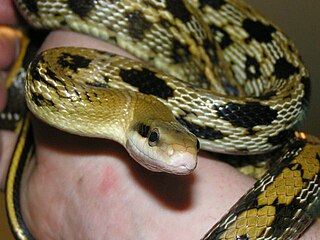
The beauty rat snake, also called the beauty ratsnake, the beauty snake, or the cave racer, is a species of snake in the family Colubridae. The species is native to the eastern and southeastern regions of Asia. It is a long, thin, semi-arboreal species of snake with several recognized subspecies. This constrictor feeds on rodents, and though it is favored in some locations as a natural pest control or pet, it is also considered an invasive species in other locations.

Elaphe is a genus of snakes in the family Colubridae. Elaphe is one of the main genera of the rat snakes, which are found in many regions of the northern hemisphere. Elaphe species are medium to large constrictors by nature.
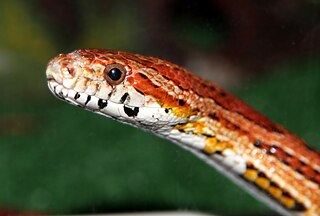
Pantherophis is a genus of nonvenomous colubrid snakes endemic to central and eastern regions of North America. It consists of the North American ratsnakes, the foxsnakes, and the cornsnakes. The genus, which contains 10 recognized species, first appeared in the fossil record in the Middle Miocene around 16.3 million years ago. They are a large terrestrial snake genus that lack subocular scales. Originally classified in the genus Elaphe, phylogenetic studies have found this taxon to be closely related to Pituophis. As with all snakes Pantherophis is an obligate faunivore with a diet that consists of small mammals, birds, reptiles and amphibians, and even insects. While many species conservation status is categorized as "least concern", many local populations in some species have declined where some places have them listed as federally protected. The corn snake is a popular pet reptile, due to the availability of captive-bred animals, their low maintenance and calm disposition, and the variety of color morphs. There are other species of Pantherophis that are in the pet trade, though are not as popular as the corn snake.
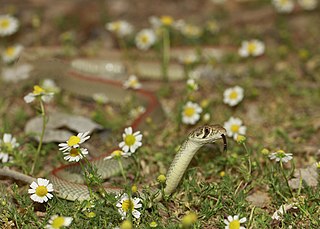
Platyceps rhodorachis the common cliff racer, Wadi racer, desert racer, braid snake, or Jan’s cliff racer, is a species of snake found in Central Asia.

The trinket snake, also known commonly as the common trinket snake, is a species of nonvenomous constricting snake in the family Colubridae. The species is native to southern Central Asia.
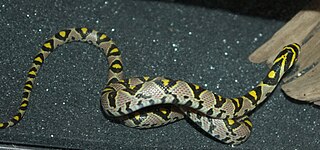
The mandarin rat snake is a species of nonvenomous colubrid snake endemic to Asia. It is closely related to Euprepiophis conspicillata, the Japanese forest rat snake. Mandarin rat snakes are one of the most popular rat snakes found in the pet trade.

Gonyosoma prasinum is a species of colubrid snake found in Asia.

Coelognathus radiatus, commonly known as the radiated ratsnake, copperhead rat snake, or copper-headed trinket snake, is a nonvenomous species of colubrid snake.
The eastern trinket snake is a species of snake in the family Colubridae. The species is endemic to South Asia.
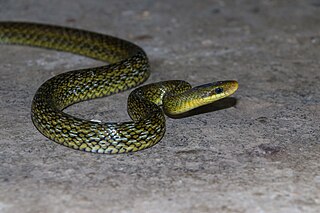
Elaphe hodgsoni, also known commonly as Hodgson's rat snake and the Himalayan trinket snake, is a species of snake in the family Colubridae. The species is native to parts of Asia around the Himalayas.

Gonyosoma oxycephalum, known commonly as the arboreal ratsnake, the red-tailed green rat snake, and the red-tailed racer, is a species of snake in the family Colubridae. The species is endemic to Southeast Asia.

Ptyas mucosa, commonly known as the Oriental rat snake, dhaman or Indian rat snake, is a common non-venomous species of colubrid snake found in parts of South and Southeast Asia. Dhamans are large snakes. Typical mature total length is around 1.5 to 1.95 m though some exceed 2 m. The record length for this species was 3.7 m, second only to their cousin Ptyas carinata among living colubrid snakes. Despite their large size, oriental ratsnakes are usually quite slender with even a specimen of 2 m commonly measuring 4 to 6 cm only around in diameter. Furthermore, the average weight of ratsnakes caught in Java was around 877 to 940 g, though larger males of over 2.3 m may easily weigh over 2.5 kg (5.5 lb). Their color varies from pale browns in dry regions to nearly black in moist forest areas. Rat snakes are diurnal, semi-arboreal, non-venomous, and fast-moving. Rat snakes eat a variety of prey and are frequently found in urban areas where rodents thrive.

Pantherophis emoryi, commonly known as the Great Plains rat snake, is a species of nonvenomous rat snake in the family Colubridae. The species is native to the central part of the United States, from Missouri to Nebraska, to Colorado, south to Texas, and into northern Mexico.
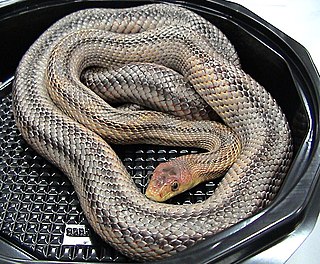
Pantherophis bairdi is a species of harmless snake in the family Colubridae. The species is native to the southwestern United States and adjacent northeastern Mexico. No subspecies are recognized as being valid.

Coelognathus is a genus of seven species of rat snakes in the subfamily Colubrinae of the family Colubridae. The species, which are native to South Asia and Southeast Asia, were formerly assigned to the genus Elaphe. Based on morphological evidence and protein similarities, in 2001, Helfenberger revalidated the name Coelognathus that had originally been proposed by Leopold Fitzinger in 1843. The distinction between Coelognathus and Elaphe was further supported by mitochondrial DNA sequence and additional morphological evidence in 2005.
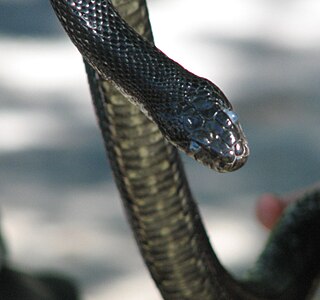
Pantherophis alleghaniensis, commonly called the eastern rat snake, is a species of non venomous snake in the family Colubridae. The species is endemic to North America.
Archelaphe is a genus of snake in the family Colubridae. The genus contains the sole species Archelaphe bella, commonly known as the Bella rat snake, which is endemic to Asia.
Euprepiophis perlaceus, also known as Sichuan rat snake or pearl-banded rat snake, is a species of snake in the family Colubridae snake. It is endemic to western Sichuan Province in China. This snake is designated as Endangered by the IUCN Red List. It is found in the Palearctic.


















